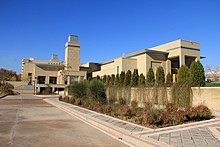Ismaili Centre, Dushanbe
| The Ismaili Centre, Dushanbe | |
|---|---|
 | |
| Religion | |
| Affiliation | Nizari Ismaili Muslim |
| Leadership | His Highness the Aga Khan |
| Location | |
| Location | 47 Ismoil Somoni Avenue; 734000 Dushanbe, Tajikistan |
| Geographic coordinates | 38°35′07″N 68°45′48″E / 38.58521°N 68.7634°E |
| Architecture | |
| Architect(s) | Farouk Noormohamed Design Associates – Vancouver, Canada |
| Type | Jamatkhana |
| Groundbreaking | 30 August 2003 |
| Completed | 2009 |
| Website | |
| https://the.ismaili/ismailicentres/dushanbe | |
The Ismaili Centre, Dushanbe is one of six such centres world-wide and is an Ismaili jamatkhana. It was the fifth purpose-built Ismaili Centre, and the first in Central Asia.
Background
Dushanbe is the capital of Tajikistan, a country characterised by an unusually extensive Ismaili population: the region of Badakhshan, which spills over northeastern Afghanistan, eastern Tajikistan and North Pakistan, is the only part of the world where Ismailis make up the majority of the population.[1] Under Soviet rule, the religion was discouraged, but since 1991 has increased its public prominence, and the Personal Representative of the Ismaili imamate has been granted full diplomatic status.[2] In May 1995, Aga Khan IV became the first Aga Khan known to have visited the region, invited by the governments of Tajikistan and Kyrgyz Republic.[3]
Function
Following extensive development work for Ismaili people in Tajikistan, the Centre was inaugurated on 12 October 2009 by the Aga Khan and the Tajikistani president, Emomali Rahmon[4] (though as of 2013 not all of its planned functionality had been implemented).[5] The centre gave the traditionally peripheral Ismailis a prominent architectural focus in the capital city,[6] while retaining the Ismaili Centres' customary sense of seclusion for those within the building,[7] and is a mark of the increasing integration of Tajik Ismailis into the global Ismaili community.[8] The Centre was designed 'to become part of the fabric of the civil life of the area',[9] and accordingly includes not only facilities for worship, but also for conferences, lectures and cultural performances (including translation booths, enabling simultaneous multilingual delivery of events).[10]
Architecture
Designed by the Canadian architect Farouk Noormohamed, and like various post-independence Tajik buildings, the Ismaili Centre evokes Samanid architecture, its brickwork particularly evoking the Ismaili Samanid Mausoleum.[11] The building is set within gardens featuring fountains and Persian silk trees.[10]
The Centre is also notable for some of its sustainability features, such as earthquake-resistance and the use of an innovative water-source heating and cooling system.[10]
References
- ^ Ismaili Muslims in the remote Pamir mountains Archived 3 March 2011 at the Wayback Machine.
- ^ Daryoush Mohammad Poor, Authority without Territory: The Aga Khan Development Network and the Ismaili Imamate (New York: Palgrave Macmillan, 2014), pp. 149, 196, 221.
- ^ Zubaidullo Ubaidulloev, 'The Revival of Islam in Post-Soviet Independent Tajikistan', pp. 10-11.
- ^ Zubaidullo Ubaidulloev, 'The Revival of Islam in Post-Soviet Independent Tajikistan', pp. 10-11.
- ^ Larisa Dodkhudoeva, Rustam Mukimov, and Katherine Hughes, 'Tajik Art: A Century of New Traditions', in The Shaping of Persian Art: Collections and Interpretations of the Art of Islamic Iran and Central Asia, ed. by Yuka Kadoi and Iván Szántó (Newcastle upon Tyne: Cambridge Scholars Publishing, 2013), pp. 276-97.
- ^ Zubaidullo Ubaidulloev, 'The Revival of Islam in Post-Soviet Independent Tajikistan', pp. 10-11.
- ^ Karim H. Karim, 'A Semiotics of Infinite Translucence: The Exoteric and Esoteric in Ismaili Muslim Hermeneutics', Canadian Journal of Communication, 40 (2015).
- ^ Daryoush Mohammad Poor, Authority without Territory: The Aga Khan Development Network and the Ismaili Imamate (New York: Palgrave Macmillan, 2014), p. 226.
- ^ Daryoush Mohammad Poor, Authority without Territory: The Aga Khan Development Network and the Ismaili Imamate (New York: Palgrave Macmillan, 2014), p. 183.
- ^ a b c 'Architecture of the Ismaili Centre, Dushanbe', the.ismaili (13 October 2009).
- ^ Larisa Dodkhudoeva, Rustam Mukimov, and Katherine Hughes, 'Tajik Art: A Century of New Traditions', in The Shaping of Persian Art: Collections and Interpretations of the Art of Islamic Iran and Central Asia, ed. by Yuka Kadoi and Iván Szántó (Newcastle upon Tyne: Cambridge Scholars Publishing, 2013), pp. 276-97.
External links
- Ismaili Centre, Dushanbe (official website)
- Archnet entry
